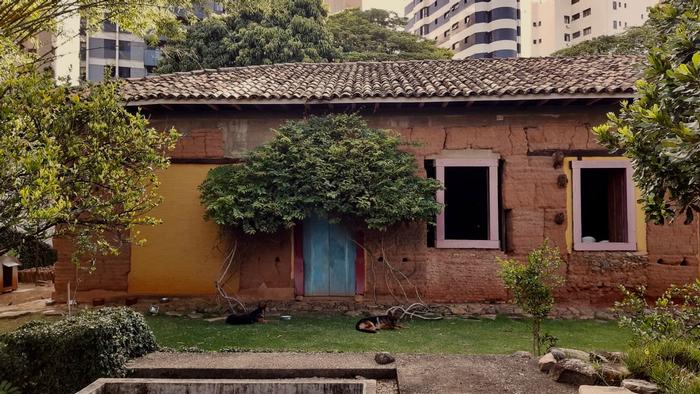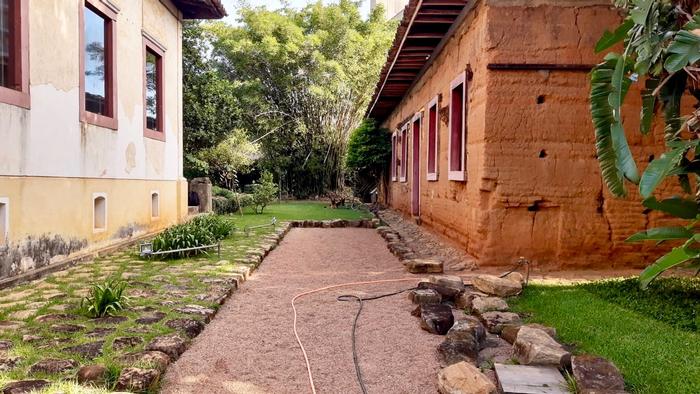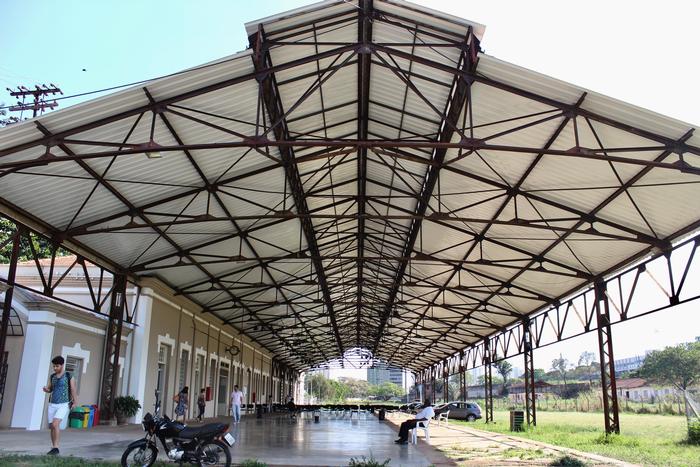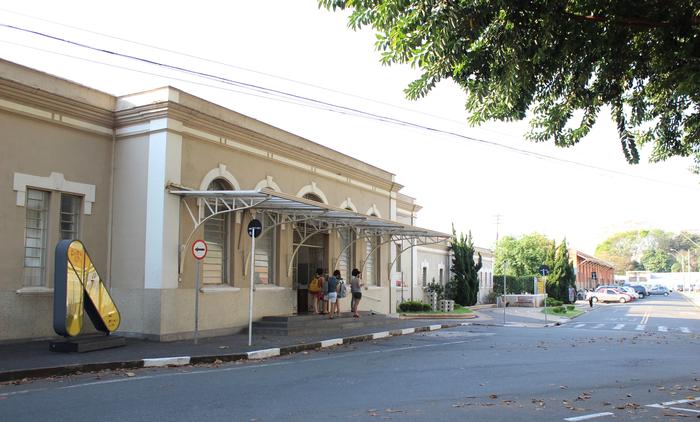[ID:3803] Sugar, coffee and real estate speculation.Brazil We first crossed paths in 2018, as we prepared for a regional meeting of architecture students in the city of São Carlos (EREA). The purpose of the meeting was to be an open arena for students to discuss how (and to what extent) the University is inserted in the city surrounding it and what is the true impact students can have in the urban life happening around them. Both of us were group leaders at our respective universities and, because we were from the same city, it made sense to organize all departure and arrival logistics together. We however ended up never meeting in person up until the departure day: our first conversations consisted of WhatsApp texts and (a lot of) shared spreadsheets.
Once we arrived in São Carlos and finally had time to connect with each other beyond our onscreen interactions, we found a wide range of common interests: understanding students’ role in society; the need to engage in learning experiences beyond what is taught the classrooms; the political issues behind architecture and urbanism; and, most importantly, a shared admiration for everything that cities can offer to the societies we live in. From four days of intense dialogue, debates, and academic exchange, arose the amazing friendship that we have cultivated for almost two years now — and a valuable partnership that led us to engage in this project together.
The city of Campinas, where we were both born and raised, is still young in comparison to other metropolises. However, throughout its 245 years of existence, the city has already gone through significant urban development processes, embraced economic conquests and challenges, overcome slavery (while learning how to live with its scars), seen high buildings rise, witnessed several political conflict, and developed a fascinating culture. Sugar, coffee, real estate speculation. These pillars have largely influenced the Brazilian economy and politics over time and the very unique intersection of all three of these elements into architectural constructions is what brought the two buildings we have selected for this project to our attention. Brazil's sugar and coffee-based economic cycles, together with real estate speculation movements, connect these buildings to the city they are inserted in and to Brazilian history as a whole. In this sense, the architecture behind these constructions offer one of the richest historic narratives of the city of Campinas itself.
The story these buildings tell starts on the railways of our city. Despite being inactive today, the railroad tracks were a direct result of the early times of Brazilian industrialization, along with the exponential growth of the coffee economy. The first railroad in the country was inaugurated in 1854, with the purpose of taking the increasing volumes of coffee cargoes to Brazil's main port (Guanabara Bay) and optimize coffee exports. In order to keep up with the Brazilian new
economic cycles, Campinas inaugurated its first train station in 1875, with thirteen operating lines. Offering the first interstate connection in the country and an alternative transportation for the rising middle class in a society that had been dominated by the coffee producer elites, its decline was unexpected. Looking at the building, the structure reveals an intense use of metallic structures, high ceilings, and many shops for the rail station passengers, all filled with art nouveau details that still stand.
After periods of intense economic growth from manufacturing and other commodities, the Great Depression did not spare the Brazilian economy — especially given its high dependability on investments coming from the United States. Coffee production gradually (but rapidly) declined, with a growing imbalance between supply and demand that could no longer keep Brazilian railroads sufficiently busy to compete with the then-rising automobile industry. In Campinas, the train station was ultimately deactivated in 1974. Even in the aftermath of the railroads demise in Brazil, the structure of the Campinas train station and its relevance to the community have remained to this date, though now in the form of a cultural center and no longer as an operating rail station. It is precisely this resilience of its architectural and urban value in our contemporary city landscape that is so intriguing.
It is possible to point out that the building of the former station and current cultural center affects the city community on three different dimensions. The first of them is territorial, as the rail tracks directly interfere in the city's landscape. The second dimension is urban planning, as the railroads shape the development of villages and neighborhoods around them, particularly when the working class starts to populate its surroundings and other economic activities follow this occupation. Finally, there is the architectural dimension, due to its prominent physical presence in the city landscape, especially when the original structures are preserved. These dimensions must always be interpreted and analyzed from a holistic perspective, seeing them as mutually complementary in the process to understand the importance of a building like this.
A former station worker, Arias, describes the end of the railway movement as an "announced fatality". Trains that used to bring traders with their shopping bags slowly stopped running at regular hours, the cabins became increasingly empty. The trains had no political or economical incentive, fighting against the cars that arrived massively from abroad as the government pushed the automobile industry forward. The close-down of the Campinas train station was only one of many signs of a declining railway industry in Brazil. All that was left to keep those memories alive were the ones who personally witnessed it and the building itself.
With the end of its main functionality and the lack of maintenance, stations in Brazil have, in most cases, become pieces of wasteland and degraded spaces. The abandonment of civil buildings is common in Brazilian contemporary cities, turning places with great historical heritage potential into inhospitable, abandoned constructions that inspire fear to citizen dwellers. In such cases, we often see constructions like these turning into just another target for real estate speculation. Gladly, the Campinas rail station had a different fate: the building now called CIS Guanabara (Cultural Centre for Social Inclusion), community activities are now harmonized with the building's historic value, and with the intervention of Condepaac (Campinas Council for the Protection of Cultural Heritage) and the support of the State University of Campinas (Unicamp), it is now a place where history can be revisited. The former rail tracks and the main building, filled with art nouveau details, still bring together city dwellers, but now not as passengers: educational activities, artistic exhibitions and local fairs attract many to the historic site of Campinas’ former rail station, keeping it as effervescent as it was before.
However, reappropriating a building is not that simple and not always successful. Even when these spaces carry with them — besides a constructive value — a significant symbolic and representative meaning, their history is not always properly taken into account. In cities of exponential growth, but with limited historic heritage preserved, modernization and functionality frequently leave important historical narratives behind. The value of a construction is often circumscribed to the economic relevance of the building and its structure, all with limited relevance to occupy a significant area in the urban growth of the metropolis. This is the story of Casa Grande and Tulha.
Once again, the context is sugar, coffee, real estate speculation. Tulha - a Portuguese term for "storage space" - was built at the end of the 1790s, the height of the sugar economy. Brazil was growing and so was the Brazilian countryside, mainly with the help of the railways. Built of clay and intense slave labour, Tulha was a high-society property, built in a favored location near the city's water sources. The property remained in its family of origin, the Sam Payo's, who, in the fall of the sugar economy around 1830, started to invest in the coffee production, when the main house (Casa Grande) was built. The house was not the most virtuous at the time, but gradually became a patrimonial highlight when its rural surroundings were replaced by high concrete buildings during the urbanization of the city, while still keeping its original features.
The Sam Payo family retained ownership of the land and buildings until 1978, when architect Antônio da Costa Santos (Toninho) used his family's estate to acquire Tulha, with the underlying purpose of using the space as an object of study for his doctorate. In this case, Toninho's involvement is extremely important to grasp the importance of this building for the community. An architect who would be elected mayor of Campinas years later, Toninho had always valued
the interaction between the city and the community. Toninho's studies were for a long time focused on the urbanization of slums as he defended the right of the city to the entire community. When he bought Tulha and understood its historical value, he fought to preserve it to the maximum, being one of the founders of Condepaac (Campinas Council for the Protection of Cultural Heritage) and turning Tulha into the first building to be legally protected as part of the municipal historic heritage.
He eventually moved in, and lived there with his wife and daughter. The walls, materials and all external features were preserved. Until mid-2001, the doors were always open to students and anyone who was interested in the story the building told. Students from architecture and history-related courses constantly planned guided visits and could, together with Toninho's family, use the space as an object of study. It was a pleasure for Toninho to keep the history of Campina alive through the Tulha clay walls. But Toninho wanted to do more for the city and its community, and started to run for mayor, being first elected as vice-mayor in 1988 and later as mayor himself in 2000. His primary motivation to engage in politics was to afford everyone "the right to the city"; "to build a socially equitable, economically viable and environmentally balanced city". Unfortunately, his speech contradicted the opinion of other political forces, especially when he insisted on fighting against real estate speculation initiatives.
This civil building has brought intellectual and academic communities together for years, as well as promoted exchange of experiences with the low-income population, all at Toninho's request. However, Campinas awoke on September 11, 2001 with the news that its mayor had been killed the night before. Later that day, the news would bring the information from the worldwide tragedy of the 9/11 attacks along with the loss of a mayor who was so dear to his community. And with his unexplained death, Tulha shut its doors to the public. Nineteen years have passed and now the house can only receive previously-scheduled visits, pre-authorized by Toninho's widow — as we ourselves had to do. The house lost many of its legal safeguards as a city patrimony, mainly with the recent movements of reversing patrimony rights of monuments in order to make "better use” of the urban space. The house currently resists with voluntary financial support for its maintenance, the support of academics who are still enchanted by the history behind each tile and are willing to keep studying it, and with the resources of Toninho's family who inherited his passion for the house.
Toninho once said that the house stood as a token of social conflicts entangled with Campinas’ urban planning history and according to William Ceschi, the family lawyer, and Leo, the householder, Toninho's murder was likely a said consequence of such conflicts. The unfortunate difference between CIS Guanabara and Tulha is that many people cross Tulha's street without having a clue of what is behind its high walls. The community that lives and works around the house is already familiar with Leo watering the plants, his dogs taking a walk and William's visits
to daily check on the house. On the other side, if you ask around, most people don't even know what Tulha is, let alone what is behind its walls.
Much more than skyscrapers, architecture and structures that defy gravity, and never before seen materials, we find the great value of a civil building to the community in the story it tells - especially in a society that treats its own historical heritage with indifference. Today we have international treaties such as the Venice Charter and the Athens Charter, that emphasize the importance of historical heritage beyond the civil building itself, but its interaction with the community. CIS Guanabara carries out activities with the most diverse public: local small producers' fairs, theatre and music performances, workshops for children from low-income families. Tulha, before Toninho passed, was a stage for debates that would gather politicians and slum dwellers, studying groups of old constructive processes.
Nowadays in Campinas, the history of the buildings blends in with the history of the city. The importance of the waterways, the sugar cane farms, the coffee producers is still present. The arrival of the railroads, the growth of the population by immigrants and the rural population still have their marks on the streets. We have already experienced several urban reforms, health planning, fights for civil rights, political conflicts and popular conquests. Many of these events are hidden around in city civil buildings and it is up to the community to keep them alive. With that in mind, we see the importance of our studies. Works like these connect the unknown past with the present. CIS Guanabara, which is today a public cultural center and an arena for social inclusion and community interaction tells stories that most of its young public is unaware of. And Tulha has managed to keep alive the passion of an architect for the stories behind a building full of history.
If you would like to contact this author, please send a request to info@berkeleyprize.org. |




